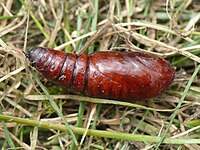Griposia aprilina
| Merveille du jour | |
|---|---|

| |

| |
| Scientific classification | |
| Domain: | Eukaryota |
| Kingdom: | Animalia |
| Phylum: | Arthropoda |
| Class: | Insecta |
| Order: | Lepidoptera |
| Superfamily: | Noctuoidea |
| Family: | Noctuidae |
| Genus: | Griposia |
| Species: | G. aprilina
|
| Binomial name | |
| Griposia aprilina | |
| Synonyms | |
|
List
| |
Griposia aprilina, also known as the merveille du jour, is a moth of the family Noctuidae, found in Asia and Europe. The species was first described by the Swedish taxonomist, Carl Linnaeus in his 1758, 10th edition of Systema Naturae.
Technical description and variation
[edit]Forewing whitish green; lines and markings velvety black, the median shade especially thick; upper stigmata large; all the black markings emphasised by white; hindwing blackish grey; the cellspot, outer line, and submarginal shade darker; a white terminal space before the black marginal line; the ab. bouveti Lucas, from France, has the head, thorax, and forewings greener, the median area of forewing without black markings.[1]
Similar specie
[edit]- Griposia pinkeri (Kobes, 1973) is found sympatrically in Asia Minor and on the Balkan Peninsula.[2]
Biology
[edit]The moth flies in September and October and comes to light.[3]
- Ovum
Laid singly or in small numbers on branches, or in crevices in the bark of oak trees (Quercus species).[4]
- Larva
The eggs hatch as the buds swell and the young larva bore into a bud which conceals them as they feed. They than feed on the flowers and grow rapidly and finally on the leaves. Larvae are greenish black, with a fulvous tinge; a dorsal series of dark medallions; dorsal line pale, interrupted, with black edges; spiracular line pale like the venter.[4][5]
- Pupa
In a large, tough cocoon, near the soil surface and usually among the roots of an oak.[4]

Distribution
[edit]It ranges from Sardinia and south-east Russia (foothills of the Ural Mountains to the Black Sea) from the southernmost part of Norway and Saint Petersburg through northern and central Europe to southern France and northern Italy, as well as in Castile. Also in western and central Anatolia and the Caucasus. Also in Asia minor. There is recent evidence from the Alborz mountain range.[6][7][8][9]
References
[edit]- ^ Seitz, A. Ed., 1914 Die Großschmetterlinge der Erde, Verlag Alfred Kernen, Stuttgart Band 3: Abt. 1, Die Großschmetterlinge des palaearktischen Faunengebietes, Die palaearktischen eulenartigen Nachtfalter, 1914
- ^ Günter Ebert (Hrsg.): Die Schmetterlinge Baden-Württembergs. 1. Auflage. Band 6. Nachtfalter IV. Noctuidae 2. Teil. Ulmer, Stuttgart (Hohenheim) 1997, ISBN 3-8001-3482-9, S. 536 f.
- ^ Kimber, Ian. "73.224 BF2247 Merveille du Jour Griposia aprilina (Linnaeus, 1758)". UKmoths. Retrieved 2 August 2023.
- ^ a b c Lorimer, R I (1983). Heath, John; Emmet, A Maitland (eds.). Cuculliinae. In The Moths and Butterflies of Great Britain and Ireland. Volume 10. Colchester: Harley Books. pp. 82–3. ISBN 0-946589-01-1.
- ^ Robinson, Gaden S.; Ackery, Phillip R.; Kitching, Ian J.; Beccaloni, George W. & Hernández, Luis M. (2010). "Search the database - introduction and help". HOSTS - A Database of the World's Lepidopteran Hostplants. Natural History Museum, London. doi:10.5519/havt50xw.
- ^ Lázló Ronkay, José Luis Yela & Márton Hreblay: Hadeninae II. In: Michael Fibiger & Martin Honey (Hrsg.): Noctuidae Europaeae. Band 5, Entomological Press, Sorø 2001, ISBN 87-89430-06-9., S. 164f
- ^ Savela, Markku, ed. (12 May 2020). "Dichonia aprilina (Linnaeus, 1758)". Lepidoptera and Some Other Life Forms. Retrieved 18 November 2020.
- ^ Bert Gustafsson (9 October 2011). "Dichonia aprilina". Naturhistoriska riksmuseet. Retrieved 6 January 2013.
- ^ Mike Wall. "2247 Merveille-du-Jour (Griposia aprilina)". Hants Moths. Retrieved 29 March 2017.
